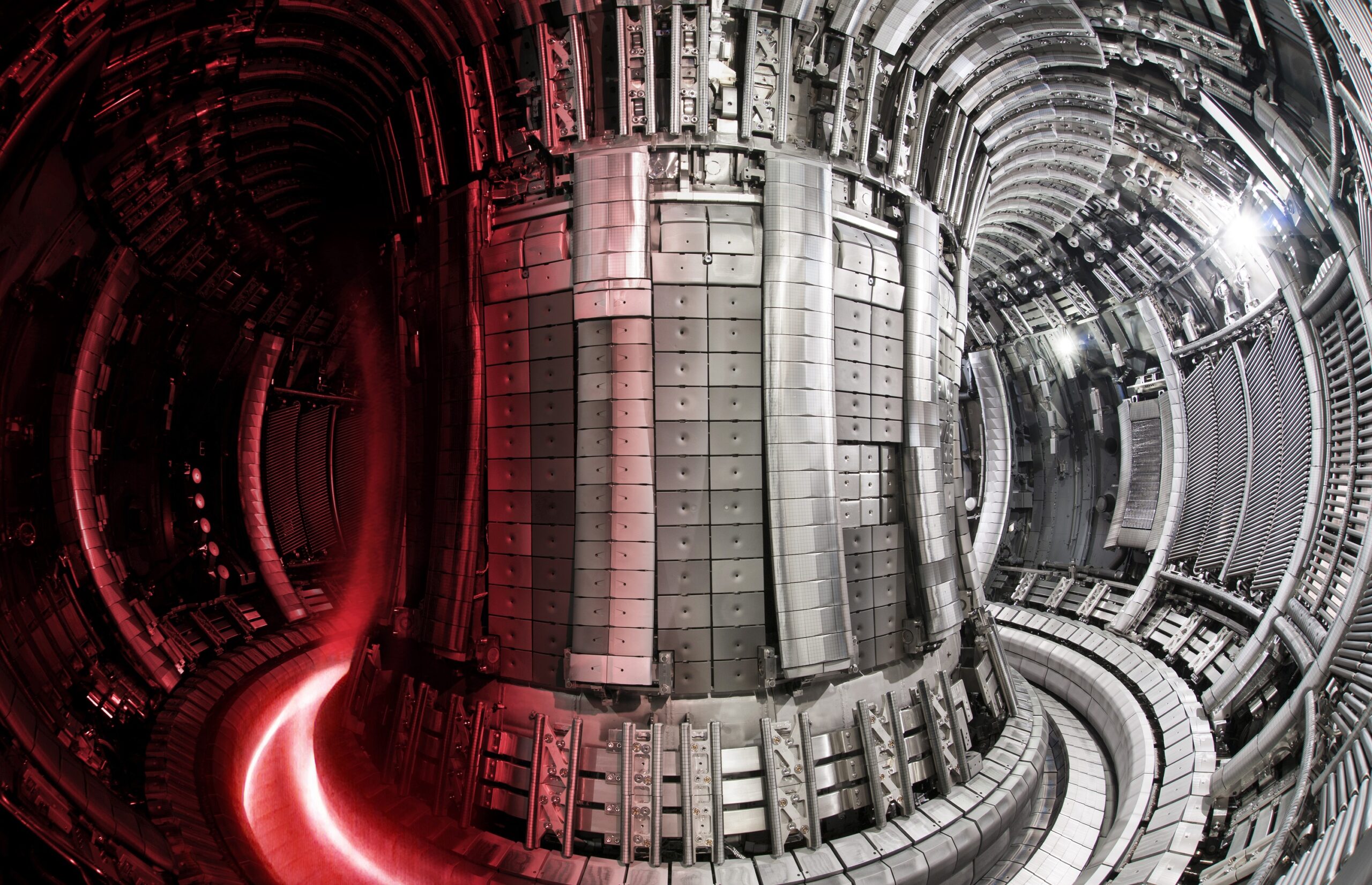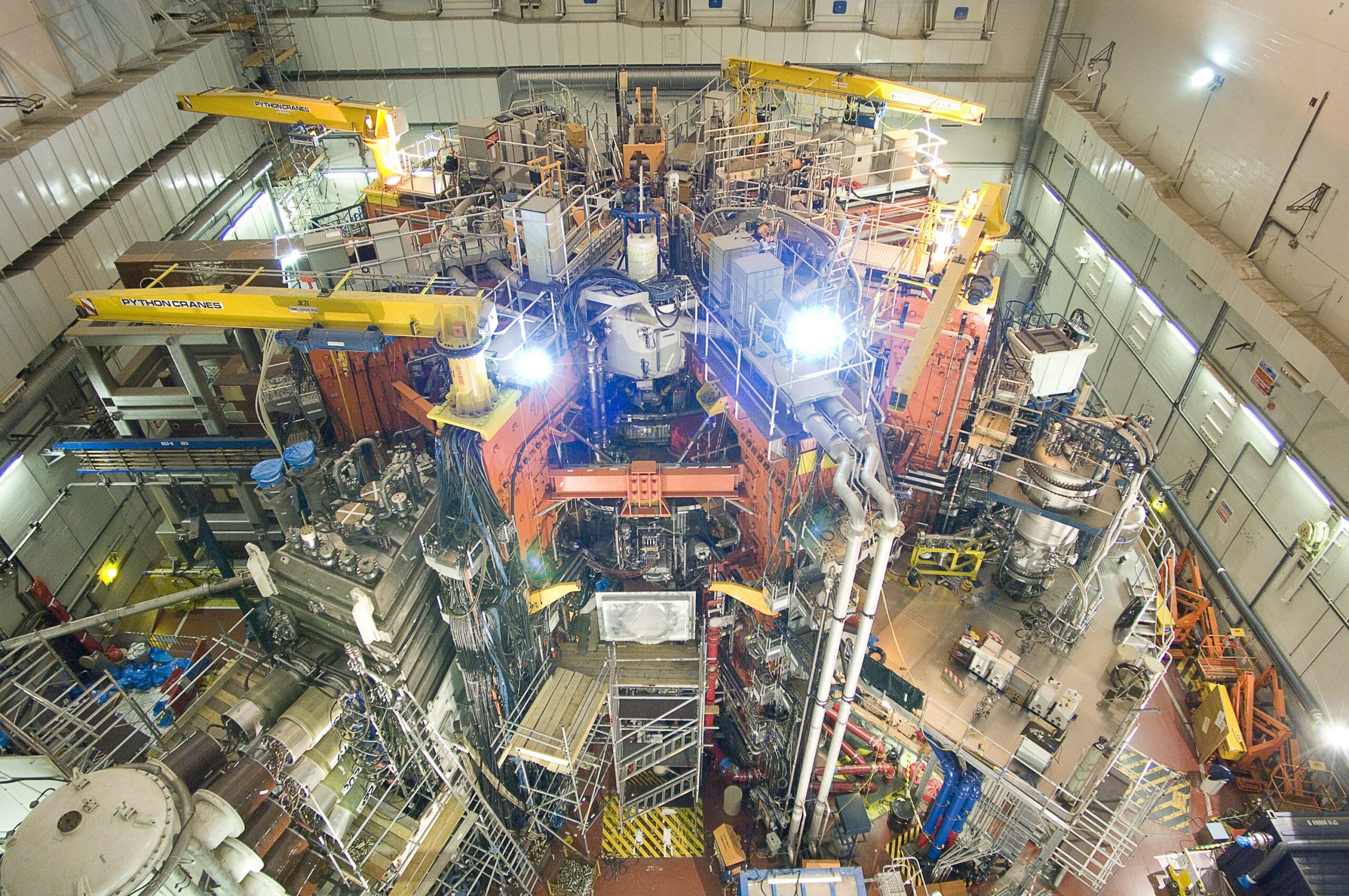- Landmark results from EUROfusion scientists and engineers at world-leading Joint European Torus (JET) facility in Oxford, UK
- Record-breaking 59 megajoules of sustained fusion energy demonstrates potential of fusion
- Results fully in line with predictions, strengthening the case for ITER
- Fusion energy can provide a safe, efficient and low-carbon energy supply
Record results announced today are the clearest demonstration in a quarter of a century of the potential for fusion energy to deliver safe and sustainable low-carbon energy.
Researchers from the EUROfusion consortium – 4,800 experts, students and staff from across Europe, including researchers from the Lithuanian Energy Institute in Lithuania, co-funded by the European Commission – used the Joint European Torus (JET) device to release a record 59 megajoules of sustained fusion energy.
This achievement on JET, the largest and most powerful operational tokamak in the world at the UK Atomic Energy Authority (UKAEA) site in Oxford, more than doubles the previous fusion energy record of 21.7 megajoules set there in 1997. It comes as part of a dedicated experimental campaign designed by EUROfusion to test over two decades’ worth of advances in fusion and optimally prepare for the start of the international ITER project.
The record and the scientific data from these crucial experiments are a major boost for ITER, the larger and more advanced version of JET. ITER is a fusion research project based in the south of France. Supported by seven members – China, the European Union, India, Japan, South Korea, Russia and the USA – ITER aims to demonstrate the scientific and technological feasibility of fusion energy.
As pressures mount to address the effects of climate change through decarbonising energy production, this success is a major step forward on fusion’s roadmap as a safe, efficient, low carbon means of tackling the global energy crisis.

Dr Bernard Bigot, Director General of ITER, said:
“A sustained pulse of deuterium-tritium fusion at this power level – nearly industrial scale – delivers a resounding confirmation to all of those involved in the global fusion quest. For the ITER Project, the JET results are a strong confidence builder that we are on the right track as we move forward toward demonstrating full fusion power.”
Prof Tony Donné, EUROfusion Programme Manager (CEO), said:
“This achievement is the result of years-long preparation by the EUROfusion team of researchers across Europe. The record, and more importantly the things we’ve learned about fusion under these conditions and how it fully confirms our predictions, show that we are on the right path to a future world of fusion energy. If we can maintain fusion for five seconds, we can do it for five minutes and then five hours as we scale up our operations in future machines.
“This is a big moment for every one of us and the entire fusion community. Crucially, the operational experience we’ve gained under realistic conditions gives us great confidence for the next stage of experiments at ITER and Europe’s demonstration power plant EU DEMO, which is being designed to put electricity on the grid.”
Prof Ian Chapman, UKAEA’s CEO, added:
“These landmark results have taken us a huge step closer to conquering one of the biggest scientific and engineering challenges of them all. It is reward for over 20 years of research and experiments with our partners from across Europe.
“It’s clear we must make significant changes to address the effects of climate change, and fusion offers so much potential. We’re building the knowledge and developing the new technology required to deliver a low-carbon, sustainable source of baseload energy that helps protect the planet for future generations. Our world needs fusion energy.”
Prof Volker Naulin, Head of the Fusion Science Department at EUROfusion, said:
“As EUROfusion we designed this experimental campaign at JET to optimally prepare for the start of ITER by investigating the energetic processes that will come into play there and to prepare the next generation of fusion researchers. The experiments confirmed our predictions, motivating us in doing our best to ensure a timely success of ITER operation. The results are support for an early decision for a European DEMO power plant, as fusion is needed for long term decarbonisation of our energy supply”
Fusion energy’s potential
Fusion, the process that powers stars like our sun, promises a near-limitless clean electricity source for the long term, using small amounts of fuel that can be sourced worldwide from inexpensive materials. The fusion process brings together atoms of light elements like hydrogen at high temperatures to form helium and release tremendous energy as heat. Fusion is inherently safe in that it cannot start a run-away process
JET of unique importance
The Joint European Torus (JET) fusion experiment – which can create plasmas reaching temperatures of 150 million degrees Celsius, 10 times hotter than the centre of the sun – is a vital test bed for ITER, one of the biggest collaborative science projects in history. JET can reach conditions similar to those in ITER and future fusion power plants, and is the only operational tokamak in the world that can use the same deuterium-tritium (D-T) fuel mix planned for those devices.
A European undertaking
JET was built and operated in Culham, UK, as a Joint Undertaking of the European Community since 1977. The facility has been operated by the UKAEA from 2000. The Euratom Research and Training programme has continuously contributed approx. 80% of the JET operation costs from 1977 until the end of 2021.
Megajoules and Megawatts explained
In its recent record-breaking experiment, JET produced a total of 59 Megajoules of heat energy from fusion over a five second period (the duration of the fusion experiment). During this experiment, JET averaged a fusion power (i.e., energy per second) of around 11 megawatts (megajoules per second).
The previous energy record from a fusion experiment, achieved by JET in 1997, was 22 megajoules of heat energy. The peak power of 16MW achieved briefly in 1997 has not been surpassed in recent experiments, as the focus has been on sustained fusion energy.






